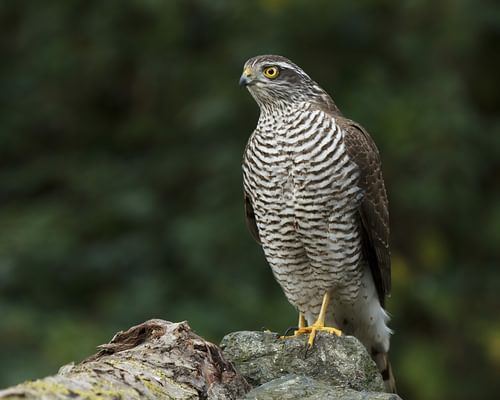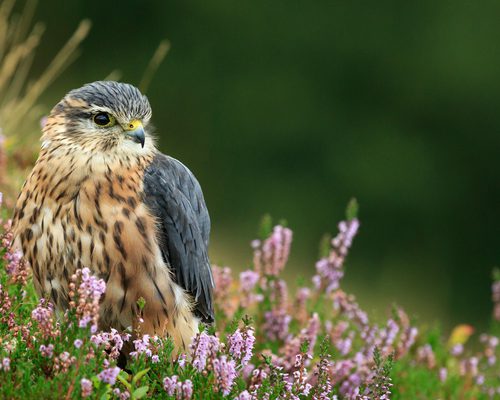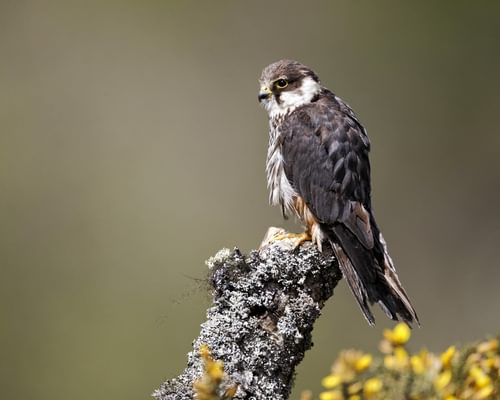Kestrel
Least ConcernFalco tinnunculus
Visual Identification
Appearance
The Kestrel is a small, compact falcon with pointed wings and a long tail. Males have a striking blue-grey head and tail, with a rufous-brown back and black wing tips. The underparts are pale with dark spotting.
Females are predominantly brown, with dark barring across the back, wings, and tail. Both sexes have distinctive black 'moustache' markings, yellow legs and feet, ceres (bill base), and eye rings.
Juveniles are similar to adult females but have paler legs and bills and more prominent streaking below.
Size
Length
32cm to 39cm
Wingspan
65cm to 82cm
Weight
136g to 252g
Habitat and Distribution
Habitats
Woodland
Garden
Wetland
Coastal
Urban
Farmland
Grassland
Desert
Tundra
Rainforest
Mountain
Savanna
Distribution
Kestrels inhabit many open habitats, including farmland, grasslands, heathland, and urban areas. They are found across Europe, Asia, and parts of Africa. In the UK, they are widespread and can be seen year-round.
Some northern populations migrate south for winter, while those in temperate regions tend to be resident. Kestrels have adapted well to human-altered landscapes, often nesting in buildings and hunting along roadsides.
Elevation Range
Up to 3,500 meters
Climate zones
Temperate, Subtropical, Tropical
Distribution Map
This map gives you a rough idea of where you might spot a Kestrel. The coloured areas show countries where these birds have been seen.
A few things to keep in mind:
- Birds might not be everywhere in the coloured areas, for example, they may be present around the coast of that country
- Where birds live can change with seasons and available food
- This map is quite simple - it doesn't show exact locations
We're working on making our maps even better! Soon, we hope to show you:
- More detailed maps for bigger countries, including state and region
- How birds move around during different seasons
Distribution by Region
Behaviour and Ecology
Bird Attributes
This feature is in beta. We'd love your feedback to improve it!
Share your thoughtsBird Attributes Explained
Our bird attributes system rates various aspects of a bird's capabilities on a scale of 0-100, based on data from field observations, scientific studies, and expert knowledge.
Attribute Categories:
- Agility: Manoeuvrability, speed, and grace in flight or movement.
- Strength: Physical power, often correlating with size and hunting abilities.
- Adaptability: Ability to thrive in various environments or changing conditions.
- Aggressiveness: Territorial behaviour and assertiveness, particularly during breeding seasons.
- Endurance: Stamina, often seen in migration patterns or foraging behaviours.
Understanding the Ratings:
- 0-20: Very Low
- 21-40: Low
- 41-60: Average
- 61-80: High
- 81-100: Very High
Remember, these attributes are relative to other bird species and don't necessarily indicate superiority.
Hover over the icon next to each attribute for more information.
Tap the icon next to each attribute for more information.
Agility
Reflects the bird's manoeuvrability, speed, and grace in flight or movement.
The Kestrel's remarkable hovering ability and swift, precise movements when hunting demonstrate exceptional agility. Their capacity to remain suspended in mid-air whilst scanning for prey, followed by rapid dives, showcases their extraordinary aerial prowess.
Strength
Indicates the bird's physical power, often correlating with size and hunting abilities.
Whilst not the strongest raptor, Kestrels possess sufficient strength to capture and carry small mammals and birds. Their ability to hover against winds and make swift diving attacks indicates moderate strength for their size.
Adaptability
Represents the bird's ability to thrive in various environments or changing conditions.
Kestrels exhibit high adaptability, thriving in diverse habitats from rural farmlands to urban environments. Their successful colonisation of human-altered landscapes and ability to nest in various structures, including buildings, demonstrates their adaptable nature.
Aggressiveness
Measures the bird's territorial behaviour and assertiveness, particularly during breeding seasons.
Kestrels display moderate aggressiveness, particularly during breeding season and when defending territory. Their solitary hunting behaviour and willingness to nest in loose colonies suggest a balanced temperament, neither overly aggressive nor docile.
Endurance
Reflects the bird's stamina, often seen in migration patterns or foraging behaviours.
The Kestrel's ability to hover for extended periods whilst hunting, coupled with their partial migratory behaviour in some populations, indicates good endurance. Their capacity to hunt actively throughout the day further supports their stamina, though they are not known for extremely long-distance flights.
Diet
Kestrels primarily feed on small mammals, particularly voles and mice. They also consume large insects, small birds, and occasionally reptiles.
Their keen eyesight allows them to spot prey from a considerable distance, often catching it with a swift dive from their hovering position.
Behaviour
Kestrels are known for their distinctive hovering flight. Its most distinctive behaviour is the ability to hover in a fixed position on rapidly beating wings, with its head remaining unerringly still, or remain motionless on an updraught while scanning the ground for prey. It drops vertically onto prey, which is then usually carried away to be eaten on a perch
Kestrels frequently perch on posts, wires, or tree branches, bobbing their tails while surveying their surroundings. They are solitary hunters but may form loose colonies during breeding season.
Vocalisation
Although generally silent birds, Kestrels have a distinctive, high-pitched call often described as a repeated 'kee-kee-kee' or 'killy-killy-killy'. This vocalisation is commonly heard during territorial disputes or when alarmed.
During courtship, males may produce a softer, chattering sound to attract females. Adults also call to maintain contact with their partners and their young.
Nesting & Breeding
Kestrels typically breed from April to July. They do not build their own nests but instead use existing cavities in trees, cliffs, or buildings. In urban areas, they may nest in specially designed boxes.
Females lay 3-6 eggs, which are creamy-white with reddish-brown spots. The eggs are incubated primarily by the female for about 28 days.
Both parents care for the chicks, which fledge after 27-35 days but remain dependent on their parents for several weeks afterwards.
Lifespan
years
The Kestrel typically lives for 4 to 6 years.
Like all birds, lifespan can be affected by factors including predation, habitat quality, disease, and access to food sources.
Conservation and Status
Global Conservation Status
While listed as Least Concern globally, Kestrel populations have declined in parts of Europe due to agricultural intensification and habitat loss.
Conservation efforts focus on maintaining suitable hunting grounds and providing nesting boxes in areas where natural sites are scarce.
Birdwatching Tips
- Look for Kestrels hovering over open fields or grasslands
- Check telephone poles and wires in rural areas for perched birds
- Listen for their high-pitched 'kee-kee-kee' call
- In the UK, watch for them along country lanes, motorways and in urban areas
- Use binoculars to spot their distinctive facial markings
- Perched kestrels have a noticeably upright posture. When in direct flight, the kestrel’s wingbeats are fast and shallow with a few glides.
Additional Information
Quick Facts
Other names:
Common Kestrel, European Kestrel
Family:
FalconidaePredators
Adult Kestrels face threats from larger raptors such as Goshawks and Peregrine Falcons. Eggs and nestlings are vulnerable to corvids, squirrels, and climbing mammals.
Did You Know?
- Kestrels can see near-ultraviolet light, helping them track vole urine trails.
- Kestrels have remarkable eyesight that may be as much as eight times stronger than ours. These birds can spot prey from about 50 meters away, more than twice the length of a tennis court.
- They have been known to cache surplus food for later consumption.
- In medieval times, lower-ranking individuals sometimes used Kestrels in falconry.
- The kestrel is also known as the Windhover due to its mastery of flight and ability to hover, an aspect that is celebrated by Gerard Manley Hopkins’ poem of the same name. “High there, how he rung upon the rein of a wimpling wing”.
Was this bird profile helpful?
Your feedback helps us improve our content
Thanks for your feedback!
Your input helps us improve our content.
Community Experience
Community Ratings
No ratings yet - be the first to rate this bird!
Latest Community Reviews
No reviews yet
Sign in to be the first to review
Community Reviews
Create Your Free Account Welcome Back!
Join our community to rate birds and share your experiences. Creating an account is completely free and only takes a minute. Sign in to your account to rate birds and share your experiences with our community.
Your information is secure and will never be shared.
By creating an account, you agree to our Privacy Policy.
FAQs
How fast can Kestrels fly?
Kestrels are better known for their deft hovering abilities than their speed, despite belonging to the fastest bird family on Earth.
Data is lacking on Eurasian Kestrel flight speeds, although migrating Lesser Kestrels can fly at 31 miles per hour (50km/h) in level flight, and the American Kestrel is said to reach 39 miles per hour (63 km/h).
Are Kestrels the smallest bird of prey in the UK?
The Kestrel is one of the smallest birds of prey in the United Kingdom, but the true honour goes to the Merlin, another small raptor from the falcon family. If you consider owls birds of prey, the introduced Little Owl trumps them both with a maximum weight of just 206 grams.
Similar Birds
References
- 1 2 3
website: BirdLife International. 2021. Falco tinnunculus. The IUCN Red List of Threatened Species 2021: e.T22696362A206316110.
View source


